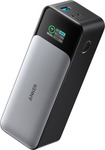Click Frenzy deal on the Anker 737 from the official Anker store. Nothing's going to beat that $111 deal for the eBay Plus weekend. This product is not in any way associated with the Boeing 737, however, you are allowed to take one onto a Boeing 737.
Ultra-Powerful Two-Way Charging: Equipped with the latest Power Delivery 3.1 and bi-directional technology to quickly recharge the portable charger or get a 140W ultra-powerful charge.
High Capacity and Long-Lasting: Featuring a 24,000mAh battery capacity and 2× longer-lasting battery life, juice up an iPhone 13 almost 5 times or a 2021 iPad Pro 12.9" 1.3 times.
Smart Digital Display: Easy-to-read digital display shows the output and input power and estimated time for the portable charger to fully recharge.
What You Get: Anker 737 Power Bank (PowerCore 24K), welcome guide, 140W USB-C to USB-C cable, 24-month stress-free warranty, and friendly customer service.
Output: 140W Max
Number of USB-C Ports: 2 USB-C Ports
Number of USB-A Ports: 1 USB-A Ports
Number of Outputs: 3
Dimensions and Weight:
Dimensions:
6.13 × 2.15 × 1.95 in / 155.7 × 54.6 × 49.5 mm
Weight:
22.22 oz / 630 g


"This product is not in any way associated with the Boeing 737" - upvoted just because you made me chuckle :)